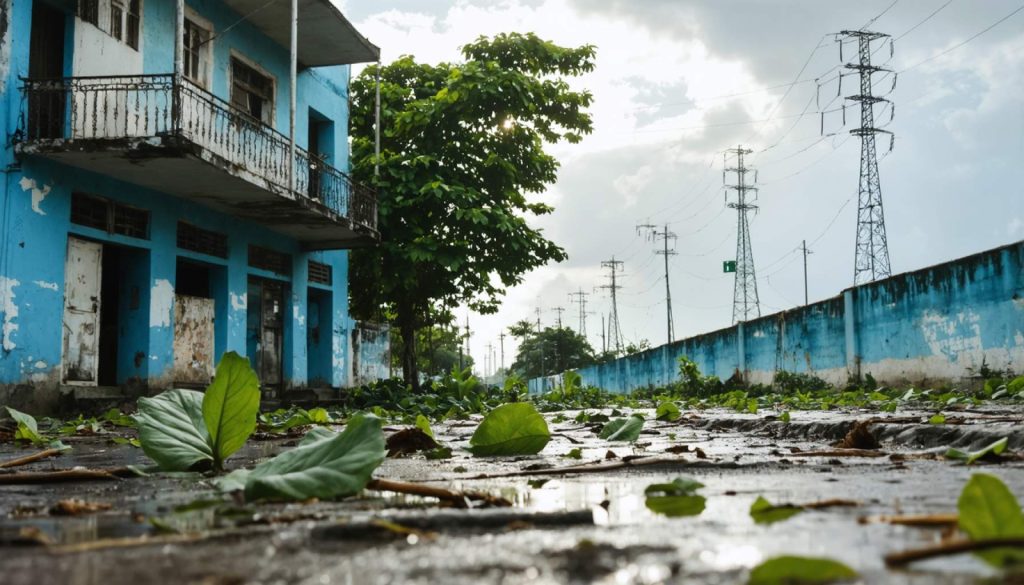
- Cuba emerges as an unexpected leader in climate action, driven by a unique blend of socialist governance and community initiatives.
- “Tarea Vida” is Cuba’s comprehensive plan tackling sea level rise, extreme weather, and agricultural challenges to protect 15% of its territory.
- Mangrove planting and sustainable agriculture are pivotal strategies for enhancing resilience against environmental threats.
- Renewable energy, water conservation, and biodiversity protection exemplify Cuba’s commitment to sustainability.
- Educational programs cultivate climate awareness, empowering citizens to contribute innovative solutions.
- Despite limited resources, Cuba highlights that effective climate action relies on unity, local knowledge, and collective well-being.
- Cuba’s transformation offers hope and a model for resilience in the face of global climate change challenges.
https://youtube.com/watch?v=ATt4ItU6E0A
Imagine stepping onto the lush, vibrant shores of Cuba, where the warm breeze carries whispers of change amidst the rustle of palm leaves. This dynamic island nation, distinguished by its fiery history and resilient people, is not only a melting pot of culture but also a quiet champion in the battle against climate change.
Cuba’s unique blend of socialist governance and community-driven initiatives has led to an unexpected leader in climate action within the Caribbean. The Cuban government, navigating the narrow straights of economic sanctions and environmental challenges, has crafted a strategic plan that harmonizes environmental conservation with economic resilience.
Central to Cuba’s strategy is the “Tarea Vida” or “Life Task,” a comprehensive plan unveiled in 2017. This initiative seeks to address the dire threats posed by rising sea levels, more intense hurricanes, and shifting agricultural conditions. With over 15% of Cuba’s territory at risk from these changes, the significance of this endeavor cannot be overstated.
Tarea Vida employs a multifaceted approach. Coastal communities have planted mangroves as formidable bulwarks against storm surges, while inland, Cuba advances sustainable agricultural practices that not only replenish soils bereft from decades of monoculture but also ensure food security. Farmers, equipped with local wisdom and governmental support, transform arid soils into fertile grounds.
Moreover, Cuban scientists and policymakers embrace a philosophy deeply rooted in sustainability. By conserving water resources, protecting biodiversity, and promoting renewable energy, the island nation paints a picture of what a climate-resilient society can look like. Solar panels now pepper the Cuban landscape, heralding a new dawn in which renewable energy powers homes and institutions.
Cuba’s stance on education nurtures a society well-versed in climate issues. Schoolchildren engage with environmental curricula from an early age, crafting citizens who not only understand the perils of climate change but also develop innovative solutions. This grassroots involvement fuels community initiatives, enhancing resilience at every societal level.
Despite having fewer resources than its wealthier neighbors, Cuba’s determination and pragmatic approach offer critical lessons. The nation stands as a testament that effective climate action hinges not solely on financial muscle but on unity, localized knowledge, and a commitment to collective well-being.
The key takeaway? While challenges loom large, Cuba’s climate strategy demonstrates the power of resilience and creativity. By investing in its people and ecosystems, Cuba showcases that even small nations can carve formidable paths towards sustainability. Hidden behind its picturesque beaches and rhythm-filled streets lies a powerful narrative of transformation, providing hope and direction in a world where climate change remains one of the greatest adversaries.
How Cuba’s Innovative Climate Strategy is Paving the Way for Global Change
Insights and Expansion on Cuba’s Climate Initiatives
Imagine stepping onto the lush, vibrant shores of Cuba, where the warm breeze carries whispers of change amidst the rustle of palm leaves. This dynamic island nation, distinguished by its fiery history and resilient people, is not only a melting pot of culture but also a quiet champion in the battle against climate change.
Cuba’s unique blend of socialist governance and community-driven initiatives has led to an unexpected leader in climate action within the Caribbean. The Cuban government, navigating the narrow straits of economic sanctions and environmental challenges, has crafted a strategic plan that harmonizes environmental conservation with economic resilience.
Tarea Vida: Beyond the Basics
Central to Cuba’s strategy is the “Tarea Vida” or “Life Task,” a comprehensive plan unveiled in 2017. This initiative seeks to address the dire threats posed by rising sea levels, more intense hurricanes, and shifting agricultural conditions. With over 15% of Cuba’s territory at risk from these changes, the significance of this endeavor cannot be overstated.
Additional Facts and Implications:
– Community Empowerment: Tarea Vida empowers local communities by involving them directly in decision-making processes. This includes community monitoring of environmental changes and participating in the development of adaptive practices.
– Integration of Indigenous Knowledge: The plan emphasizes the integration of indigenous knowledge systems, which has enhanced resilience and provided alternative strategies for environmental management.
– Dedicated Research and Development: Cuba has invested significantly in research to understand the impacts of climate change on its biodiversity, with a focus on protecting critical ecosystems such as coral reefs and rainforests.
Real-World Use Cases and Practical Applications
– Mangrove Restoration: Since 2017, tens of thousands of hectares of mangroves have been restored, providing natural protection against coastal erosion and supporting marine biodiversity.
– Urban Agriculture Innovations: Urban farming initiatives in cities like Havana have expanded rapidly, reducing the carbon footprint associated with transporting food and bolstering local food security.
Market Forecasts and Industry Trends
While Cuba lacks the financial backing of wealthier nations, its innovative approaches in sectors like agriculture could influence global sustainable farming trends. The reliance on organic methods and permaculture is drawing international attention as a model of sustainability.
Comparisons and Reviews
Compared to other Caribbean nations, Cuba’s approach is holistic and deeply integrative. While countries like Puerto Rico and the Bahamas have implemented renewable energy strategies, Cuba distinguishes itself through extensive community engagement and education-focused initiatives.
How to Apply Cuba’s Lessons in Your Community
1. Engage Young Minds: Begin environmental education early in schools to build a culture of sustainability from a young age.
2. Leverage Local Knowledge: Incorporate local wisdom and traditional practices in your community’s environmental strategies.
3. Community Empowerment: Encourage community-driven projects that involve public participation in climate action plans.
Pros and Cons Overview
Pros:
– Strong community involvement ensures plans are tailored to local needs.
– Focus on education creates a well-informed populace ready to tackle climate challenges.
– Emphasis on biodiversity and ecosystem protection enhances overall environmental health.
Cons:
– Economic constraints limit the scale and speed of implementations.
– Political and economic isolation might hinder technology transfer and international partnerships.
Controversies & Limitations
Despite its successes, Cuba’s climate initiatives are not without challenges. Economic sanctions restrict access to advanced technologies and international funding. Moreover, while Tarea Vida is ambitious, continuous economic and political stability is critical for its sustained success.
Recommendations and Quick Tips
– Learn from Cuba’s Model: Community engagement and education should form the backbone of any local or national climate strategy.
– Adopt Renewable Energy Solutions: Even small-scale integration of solar panels and wind energy can create significant environmental impacts.
– Prioritize Organic Farming: Support local and organic farming initiatives to reduce dependency on chemical fertilizers and enhance local food security.
For those looking to dive deeper into sustainable practices and global climate strategies, exploring governmental and non-governmental resources can provide diverse perspectives and actionable insights. Cuba’s journey serves as a powerful testament to the impact of creativity and unity in addressing some of the world’s most pressing challenges.
For more on sustainable development and international policies, visit United Nations.



